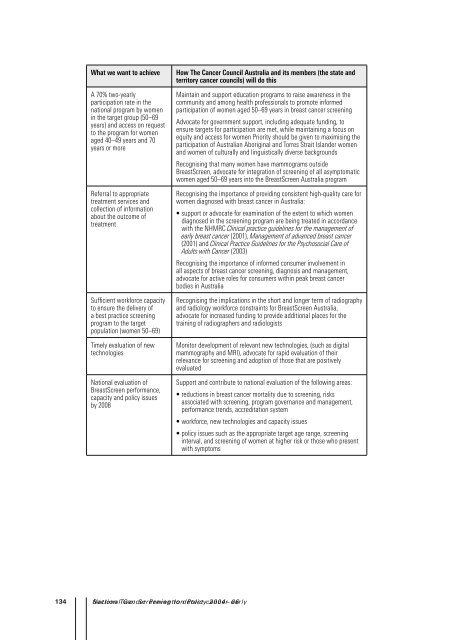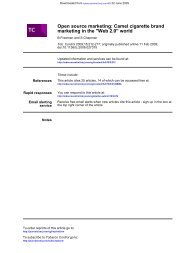National Cancer Prevention Policy - Tobacco Control Supersite
National Cancer Prevention Policy - Tobacco Control Supersite
National Cancer Prevention Policy - Tobacco Control Supersite
You also want an ePaper? Increase the reach of your titles
YUMPU automatically turns print PDFs into web optimized ePapers that Google loves.
What we want to achieve How The <strong>Cancer</strong> Council Australia and its members (the state and<br />
territory cancer councils) will do this<br />
A 70% two-yearly<br />
participation rate in the<br />
national program by women<br />
in the target group (50–69<br />
years) and access on request<br />
to the program for women<br />
aged 40–49 years and 70<br />
years or more<br />
Referral to appropriate<br />
treatment services and<br />
collection of information<br />
about the outcome of<br />
treatment<br />
Sufficient workforce capacity<br />
to ensure the delivery of<br />
a best practice screening<br />
program to the target<br />
population (women 50–69)<br />
Timely evaluation of new<br />
technologies<br />
<strong>National</strong> evaluation of<br />
BreastScreen performance,<br />
capacity and policy issues<br />
by 2008<br />
134 <strong>National</strong> Section Two: <strong>Cancer</strong> Screening <strong>Prevention</strong> to detect <strong>Policy</strong> cancer 2004 – early 06<br />
Maintain and support education programs to raise awareness in the<br />
community and among health professionals to promote informed<br />
participation of women aged 50–69 years in breast cancer screening<br />
Advocate for government support, including adequate funding, to<br />
ensure targets for participation are met, while maintaining a focus on<br />
equity and access for women Priority should be given to maximising the<br />
participation of Australian Aboriginal and Torres Strait Islander women<br />
and women of culturally and linguistically diverse backgrounds<br />
Recognising that many women have mammograms outside<br />
BreastScreen, advocate for integration of screening of all asymptomatic<br />
women aged 50–69 years into the BreastScreen Australia program<br />
Recognising the importance of providing consistent high-quality care for<br />
women diagnosed with breast cancer in Australia:<br />
• support or advocate for examination of the extent to which women<br />
diagnosed in the screening program are being treated in accordance<br />
with the NHMRC Clinical practice guidelines for the management of<br />
early breast cancer (2001), Management of advanced breast cancer<br />
(2001) and Clinical Practice Guidelines for the Psychosocial Care of<br />
Adults with <strong>Cancer</strong> (2003)<br />
Recognising the importance of informed consumer involvement in<br />
all aspects of breast cancer screening, diagnosis and management,<br />
advocate for active roles for consumers within peak breast cancer<br />
bodies in Australia<br />
Recognising the implications in the short and longer term of radiography<br />
and radiology workforce constraints for BreastScreen Australia,<br />
advocate for increased funding to provide additional places for the<br />
training of radiographers and radiologists<br />
Monitor development of relevant new technologies, (such as digital<br />
mammography and MRI), advocate for rapid evaluation of their<br />
relevance for screening and adoption of those that are positively<br />
evaluated<br />
Support and contribute to national evaluation of the following areas:<br />
• reductions in breast cancer mortality due to screening, risks<br />
associated with screening, program governance and management,<br />
performance trends, accreditation system<br />
• workforce, new technologies and capacity issues<br />
• policy issues such as the appropriate target age range, screening<br />
interval, and screening of women at higher risk or those who present<br />
with symptoms




